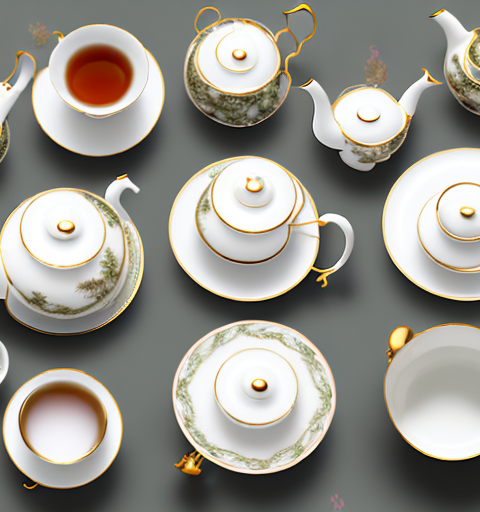Tea stains on ceramic teapots can be unsightly and difficult to remove, especially on teapots with a speckled glaze. However, with the right approach and a little effort, you can restore your teapot to its former glory. In this article, we will explore the causes of tea stains on ceramic teapots, the importance of regular cleaning to prevent stains, different types of tea stains and their impact on ceramics, as well as effective methods and natural remedies for removing tea stains. We will also delve into the role of vinegar, baking soda, lemon juice, and commercial cleaning products in tea stain removal. Additionally, we will share tips and tricks for preventing future stains, common mistakes to avoid, expert advice on tackling stubborn stains, and alternative methods such as steam cleaning or ultrasonic cleaning. By the end of this article, you will have a comprehensive understanding of how to remove tea stains from your ceramic teapot and keep it looking pristine.
Understanding the causes of tea stains on ceramic teapots
Tea stains on ceramic teapots can occur due to multiple factors. One of the primary causes is the tannins present in tea. Tannins are natural compounds found in tea leaves that can easily adhere to the porous surface of ceramic teapots and form stains over time. Additionally, the temperature of the tea can also influence the severity of the stains. Hot tea has a greater capacity to leave stains compared to cold tea.
Furthermore, brewing techniques can also contribute to the formation of tea stains. If tea bags or loose tea leaves are left in the teapot for an extended period, the tannins have more time to seep into the ceramic and create stubborn stains. Lastly, the type of tea used can affect the intensity and color of the stains. Black teas, such as Assam or Earl Grey, tend to generate darker, more noticeable stains compared to lighter teas like green or white tea.
Another factor that can contribute to tea stains on ceramic teapots is the quality of the water used for brewing. Hard water, which contains high levels of minerals like calcium and magnesium, can leave behind mineral deposits on the teapot’s surface, making it more prone to staining. Using filtered or distilled water can help reduce the likelihood of mineral buildup and tea stains.
In addition to tannins, tea contains pigments called flavonoids, which can also contribute to the formation of stains. These pigments are responsible for the color of the tea and can easily bind to the ceramic surface, especially if the teapot is not properly cleaned after each use. Regular cleaning and maintenance of the teapot, including gentle scrubbing with a non-abrasive sponge or brush, can help prevent the buildup of tea stains.
The importance of regular cleaning to prevent tea stains
Regular cleaning is crucial for preventing tea stains on ceramic teapots. By promptly rinsing your teapot with warm water after each use and gently scrubbing the interior with a soft brush or sponge, you can remove any residue that could potentially lead to stains. It is essential to note that avoiding the use of abrasive cleaners or scouring pads is crucial to prevent scratching the teapot’s surface, especially for teapots with delicate speckled glaze.
Furthermore, it is recommended to give your teapot a deeper cleaning at least once a week. This involves using a mild dish soap or baking soda mixed with water to create a paste that can be applied to the stained areas. Gently scrubbing the stains with this mixture helps break down the tannins and remove the discoloration. Following this, thoroughly rinse the teapot to ensure no residue is left behind.
In addition to regular cleaning, it is also important to pay attention to the exterior of the teapot. Wiping the outside of the teapot with a damp cloth can help remove any tea stains or residue that may have accumulated. For teapots with intricate designs or patterns, it is advisable to use a soft-bristled brush to gently clean the exterior without causing any damage.
Exploring different types of tea stains and their impact on ceramic teapots
Tea stains can manifest in various forms and intensities, depending on the tea type and the length of time the stains have had to develop. Fresh tea stains are usually easier to remove compared to older, more stubborn stains. Additionally, the color of the tea can affect the appearance of the stains on ceramic teapots.
For example, black tea stains tend to be darker and more noticeable, while green tea stains can be lighter in color. Over time, neglected tea stains may become deeply ingrained in the ceramic, making them more challenging to remove. Therefore, it is advisable to address tea stains promptly and regularly clean your teapot to prevent them from becoming deeply set.
Oolong tea stains, on the other hand, can vary in intensity depending on the oxidation level of the tea leaves. Lightly oxidized oolong teas may leave lighter stains, while heavily oxidized oolong teas can result in darker and more stubborn stains. It is important to note that the temperature of the water used to brew the tea can also impact the intensity of the stains.
In addition to the type and color of the tea, the material of the ceramic teapot can also influence the appearance and removal of tea stains. Porous ceramics, such as unglazed clay teapots, are more prone to absorbing tea stains and may require more thorough cleaning. Glazed ceramic teapots, on the other hand, have a smoother surface that can make it easier to remove stains, but they may still require regular maintenance to prevent buildup.
Step-by-step guide to removing tea stains from ceramic teapots with speckled glaze
Removing tea stains from ceramic teapots with a speckled glaze requires a step-by-step approach to ensure effective stain removal without damaging the delicate glaze. Follow these instructions to remove tea stains:
- Start by rinsing the teapot with warm water to loosen any loose tea leaves or debris.
- Prepare a mild cleaning solution by mixing warm water with a few drops of dish soap.
- Dampen a soft sponge or cloth with the cleaning solution and gently scrub the stained areas of the teapot.
- If the stains persist, create a paste using baking soda and water and apply it to the stained areas.
- Gently scrub the paste onto the stains using a soft brush, making sure to avoid scrubbing too vigorously to prevent scratching the glaze.
- Rinse the teapot thoroughly with warm water to remove any cleaning residue.
- Inspect the teapot for any remaining stains. If necessary, repeat the cleaning process or consider using alternative stain removal methods.
- Once the stains are successfully removed, dry the teapot with a clean cloth or allow it to air dry completely before storing or using it again.
It is important to note that different types of tea stains may require different cleaning methods. For example, stubborn stains caused by tannins in black tea may require additional steps or a stronger cleaning solution. If you are unsure about the best approach for removing specific tea stains, it is recommended to consult the manufacturer’s instructions or seek professional advice.
Effective natural remedies for removing tea stains from ceramic teapots
If you prefer natural remedies, several household items can help you remove tea stains from ceramic teapots effectively. Here are a few natural options:
Vinegar: Mix one part white vinegar with three parts warm water. Soak a sponge or cloth in this solution and scrub the stained areas of the teapot. The mild acidity of vinegar can help break down the stains.
Baking soda: Create a paste by combining baking soda and water. Apply the paste to the tea stains and gently scrub with a soft brush or cloth. Baking soda acts as a gentle abrasive and assists in removing the tea stains.
Lemon juice: Squeeze fresh lemon juice onto a soft cloth or sponge and rub it onto the stained areas. The natural acidity in lemon juice helps dissolve tea stains and restore the teapot’s shine.
White toothpaste: Another effective natural remedy for removing tea stains from ceramic teapots is white toothpaste. Apply a small amount of toothpaste to a soft cloth or sponge and gently rub it onto the stained areas. The mild abrasiveness of toothpaste can help lift the tea stains and leave your teapot looking clean and shiny.
The role of vinegar in removing stubborn tea stains from ceramic teapots
Vinegar can be incredibly useful in removing stubborn tea stains from ceramic teapots. As mentioned earlier, the mild acidity of vinegar helps break down the tannins present in tea stains, making them easier to remove. When using vinegar, it is essential to dilute it with water to prevent any potential damage to the teapot’s surface. Additionally, always rinse the teapot thoroughly after using vinegar to ensure no residual odor or taste remains.
Another benefit of using vinegar to remove tea stains from ceramic teapots is that it is a natural and non-toxic cleaning agent. Unlike harsh chemical cleaners, vinegar is safe to use and does not pose any health risks. This makes it an ideal choice for those who prefer eco-friendly cleaning solutions.
In addition to its stain-removing properties, vinegar can also help eliminate any mineral deposits or hard water stains that may have accumulated on the teapot’s surface. The acidic nature of vinegar helps dissolve these deposits, leaving the teapot looking clean and shiny.
Using baking soda as a powerful cleaner for tea-stained ceramic teapots
Baking soda is a versatile and powerful cleaner that can effectively tackle tea stains on ceramic teapots. Its mild abrasive properties help scrub away the stains without causing damage to the teapot’s surface. To use baking soda, create a paste by mixing it with a small amount of water until you achieve a thick consistency. Apply the paste to the stained areas, gently scrub with a soft brush or cloth, and rinse thoroughly. Baking soda offers an economical and environmentally friendly option for stain removal.
In addition to its stain-removing properties, baking soda also helps eliminate odors from ceramic teapots. The alkaline nature of baking soda helps neutralize any lingering smells, leaving your teapot fresh and ready for use. Simply sprinkle a small amount of baking soda inside the teapot, let it sit for a few hours, and then rinse it out thoroughly. This simple trick can help keep your teapot smelling clean and odor-free.
How to use lemon juice to restore the shine of a tea-stained ceramic teapot
Lemon juice is an excellent natural remedy for removing tea stains and restoring the shine of a tea-stained ceramic teapot. The natural acidity in lemon juice helps dissolve the stains and leaves the teapot looking clean and shiny. To use lemon juice, squeeze fresh lemon juice onto a soft cloth or sponge and gently rub it onto the stained areas. Allow the juice to sit for a few minutes to penetrate the stains, then rinse the teapot thoroughly to remove any residual lemon juice.
In addition to its stain-removing properties, lemon juice also has a pleasant citrus scent that can help eliminate any lingering odors in the teapot. This makes it a great choice for not only restoring the appearance of the teapot but also refreshing its overall aroma. After rinsing the teapot, you can further enhance its shine by drying it with a soft, lint-free cloth. This will help prevent any water spots or streaks from forming on the surface of the teapot, leaving it looking even more polished and pristine.
Exploring commercial cleaning products specifically designed for tea stain removal on ceramics
If natural remedies do not yield satisfactory results, there are commercial cleaning products available that specifically target tea stain removal on ceramics. These products are formulated with powerful ingredients and are designed to safely and effectively remove stubborn stains. When using commercial cleaners, always follow the instructions provided by the manufacturer and take necessary precautions, such as wearing gloves or working in a well-ventilated area.
Tips and tricks for preventing future tea stains on your favorite ceramic teapot
Preventing future tea stains on your ceramic teapot is essential to maintain its appearance. Here are some tips and tricks to help you avoid tea stains:
- Regularly clean your teapot after each use by rinsing it with warm water and gently scrubbing the interior to remove any residue.
- Avoid leaving tea bags or loose leaves in the teapot for extended periods.
- Consider using a tea strainer or infuser to minimize contact between tea leaves and the teapot’s interior.
- Try using a ceramic coaster or trivet to protect the teapot’s surface from direct contact with heat, reducing the likelihood of intense tea stains.
- When brewing tea, avoid using excessively hot water as it can increase the chances of tea stains.
Common mistakes to avoid when trying to remove tea stains from ceramic teapots
When attempting to remove tea stains from ceramic teapots, it is important to be aware of common mistakes to avoid, as they can potentially damage the teapot or hamper your stain removal efforts. Avoid the following mistakes:
- Using harsh or abrasive cleaners that can scratch or dull the teapot’s surface.
- Scrubbing too vigorously, especially on delicate speckled glaze teapots, as it can damage the glaze and cause scratches.
- Using metal scouring pads or abrasive brushes that can leave marks or scratches on the teapot.
- Ignoring the importance of regular cleaning, as neglect can allow stains to become deeply set and more challenging to remove.
Expert advice on tackling deep-set or persistent tea stains on speckled glaze ceramics
If you are faced with deep-set or persistent tea stains on speckled glaze ceramics, seeking expert advice can be helpful. Ceramic restoration professionals or specialists may have specific techniques or products that can effectively tackle stubborn stains without causing further damage to the teapot’s surface. Consulting an expert can provide tailored solutions for your specific situation.
Understanding the benefits of regular maintenance to keep your ceramic teapot stain-free
Regular maintenance is essential to keep your ceramic teapot stain-free and in pristine condition. By implementing regular cleaning routines, promptly addressing stains, and following preventive measures, you can significantly prolong the teapot’s lifespan and ensure it remains aesthetically pleasing. Additionally, regular maintenance helps avoid the accumulation of stubborn tea stains that may require more extensive cleaning methods or professional assistance.
Exploring alternative methods for removing tea stains, such as steam cleaning or ultrasonic cleaning
While the methods mentioned earlier are effective for removing tea stains from ceramic teapots, there are alternative methods worth exploring, such as steam cleaning or ultrasonic cleaning. Steam cleaning involves using high-pressure steam to loosen and remove stains, while ultrasonic cleaning utilizes ultrasonic waves and a cleaning solution to remove dirt and stains from delicate surfaces. However, it is important to ensure these methods are suitable for your ceramic teapot and follow the manufacturer’s instructions or seek professional guidance.
With the comprehensive information provided in this article, you now have a range of techniques and remedies at your disposal to remove tea stains from the ceramic body of your teapot with a speckled glaze. Whether you choose natural remedies, commercial cleaning products, or alternative methods, remember to always approach stain removal with care and tailor your approach based on the specific needs of your teapot. By taking proactive measures and implementing regular cleaning routines, you can ensure your favorite teapot remains stain-free, allowing you to enjoy countless cups of delicious tea in the future.






